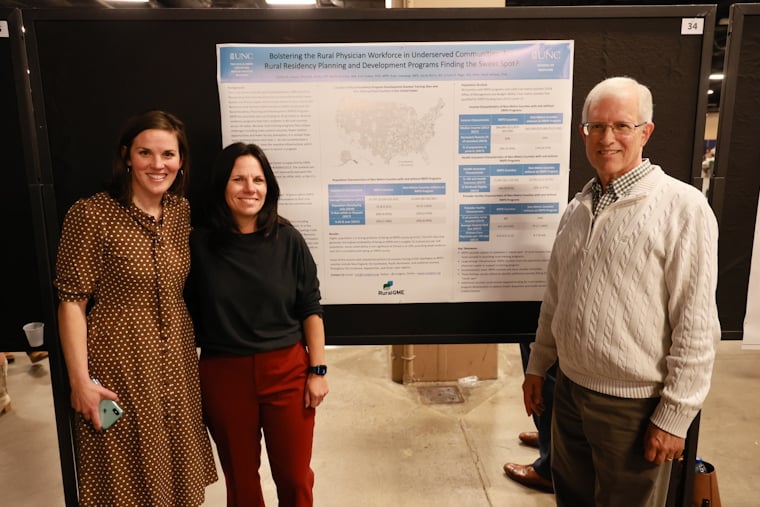
Studies show that while 20 percent of the US population lives in rural communities, only 11 percent of physicians practice in such areas. Several organizations are investing in improving health care access for patients in underserved communities, including the ACGME, through its accreditation framework for medically underserved areas and populations.
In the poster, “Bolstering the Rural Physician Workforce in Underserved Communities: Are Rural Residency Planning and Development Programs Finding the Sweet Spot?” Emily M. Hawes, PharmD and team use data about current Rural Residency Planning and Development (RPPD) programs to determine commonalities among these programs and their geographical location to identify potential sites for future RRPD programs. The poster was featured in the Poster Hall at the 2023 ACGME Annual Educational Conference, held February 23-25, 2023, in Nashville, Tennessee.
Poster Title: Bolstering the Rural Physician Workforce in Underserved Communities: Are Rural Residency Planning and Development Programs Finding the Sweet Spot?
Primary Author: Emily M. Hawes, PharmD
Co-Authors: Molly Ormsby, MA; Erin Fraher, PhD, MPP; Evan Galloway, MPS; Jacob Rains, BA; Cristen P. Page, MD, MPH; Mark Holmes, PhD
ACGME: Tell us about your academic and professional role.
Hawes: I am an associate professor in the University of North Carolina (UNC) Department of Family Medicine and UNC School of Pharmacy, and a leader in rural education and practice innovation. I serve as deputy director of the Health Resources and Services Administration (HRSA)-funded Rural Residency and Teaching Health Center Planning and Development Technical Assistance Centers, supporting the development of more than 100 grantees starting residency programs across numerous specialties in underserved settings.
ACGME: Can you briefly describe your research project for us?
Hawes: Recognizing the association between training in rural communities and increased probability of future practice in rural communities, HRSA developed the Rural Residency Planning and Development (RRPD) program, which provides eligible rural health facilities up to $750,000 to create new rural residency programs in family medicine, internal medicine, psychiatry, and general surgery over a three-year period. The purpose of this research study is to describe the characteristics of RRPD programs, compare the characteristics of counties with and without these programs, and identify rural places where future programs could be developed.
ACGME: What inspired you to do this project?
Hawes: Rural residency education is an effective mechanism to increase physician supply in rural communities. Unfortunately, only two percent of residency education occurs in rural areas. Starting and sustaining a rural residency program is difficult. Rural hospitals and clinics face unique challenges compared to their urban counterparts, such as lower patient volumes to meet accreditation requirements, inadequate Centers for Medicare and Medicaid Services (CMS) funding, difficulty recruiting faculty members, and limited educational resources. The RRPD program has been able to overcome many of these barriers and developed 35 new rural programs in high-need specialties with 463 accredited positions. Our inspiration came from working with current grantees as the Technical Assistance Center and wanting to support continued growth of rural residency educational programs.
ACGME: What did you discover?
Hawes: Using a logistic regression, we found that higher population and primary care physician supply were strong predictors, while social vulnerability was a weak predictor, of being an RRPD county compared to other rural counties. Although some RRPD programs were in remote communities with low population, the plurality of RRPD programs were in counties adjacent to metro counties and had larger populations. Higher population is a strong predictor of being an RRPD county (p<0.01). The primary care physician ratio that generates the highest probability of being an RRPD site is roughly 10.3 physicians per 10,000 people. Yet RRPD counties are socially vulnerable, with a social vulnerability index (SVI) significant at 10 percent, providing weak evidence that the SVI is correlated with being an RRPD county. For more information, read this article.
ACGME: What was the main takeaway?
Hawes: RRPD counties appear to represent a “sweet spot” for launching rural residency educational programs in communities that have the population and existing physician supply to support a program but also are more socially vulnerable with high-need populations. Additional rural areas in the US fitting this “sweet spot” could pursue funding for future rural program development to address health disparities and health workforce maldistribution.
ACGME: Who could benefit from this?
Hawes: It is critical to set programs up for success by right sizing the program for the community characteristics. Areas of the country with substantial portions of counties having similar typologies as RRPD counties include New England, the Southwest, Pacific Northwest, and scattered counties throughout the Southeast, Appalachian, and Great Lakes regions.
In addition to the RRPD program, the findings may have relevance to other federally funded programs seeking to expand training in rural and underserved communities, including Teaching Health Center Graduate Medical Education and the Veterans Affairs’ (VA’s) efforts through their Mission Act. This may inform state and local policymakers and regional graduate medical education partners such as Offices of Rural Health, Indian Health Service Area Headquarters, and Area Health Education Centers looking to address rural health disparities through training opportunities and partnerships.
